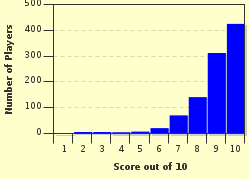Quiz Answer Key and Fun Facts
1. Many of the founding contributors to the "Bulletin of Atomic Scientists" (the magazine featuring the clock) had previously been members of the "project" that developed the atomic bomb during World War II. What was this project called?
2. The clock first appeared on the cover of the June 1947 issue of The "Bulletin", where it was set at 7 minutes to midnight. A major focus of that issue was the after-effects of the atomic bombings of what two Japanese cities in August, 1945?
3. The first movement of the clock on the "Bulletin"'s cover, to 3 minutes to midnight, occurred in October 1949. What nation caused this movement by becoming the second in the world to possess the bomb?
4. The closest the Doomsday Clock has ever reached to midnight is 2 minutes. The movement to 11:58 occurred in September 1953 in response to the testing by two nations of a much more powerful bomb based on the fusion of what element?
5. Although the passage of various non-proliferation treaties moved the clock back to 12 minutes to midnight in 1972, it soon began another push towards midnight. The main impetuses behind this push were the spreading of nuclear weapons to South Asia and the invasion of what country by the Soviet Union in December 1979?
6. The clock began moving back away from midnight in the late 1980s, reaching its furthest reach of 17 minutes away in 1991. One key reason for this was the willingness of the General Secretary of the Soviet Communist Party and later President of the Soviet Union to step away from the brink and let Eastern European nations escape Soviet control. Who was this?
7. Although the Cold War may have ended, the threat of nuclear weapons did not, and the clock soon began moving once more closer to midnight. The movement accelerated with the 1998 atomic tests performed by India and which of its neighbors?
8. The 2007 move of the Clock to five minutes to midnight was based both on the continuing failure of the United States and Russia to disarm and the recent nuclear tests in what country, which was led at the time by Kim Jong-Il?
9. One place which may have been the closest the United States and Soviet Union ever came to all-out war was NOT immediately reflected in the clock's hands. What nation was the site of a namesake 1962 "crisis" involving the presence of Soviet missiles?
10. The position of the clock is governed not only by the threat of nuclear war, but also by other possible sources of "catastrophic destruction" like climate change and bioterrorism. One feared mechanism for the latter of these is the spores of what bacterium, which were delivered by mail in a 2001 bioterrorism attack?
Source: Author
kevinatilusa
This quiz was reviewed by FunTrivia editor
bloomsby before going online.
Any errors found in FunTrivia content are routinely corrected through our feedback system.

